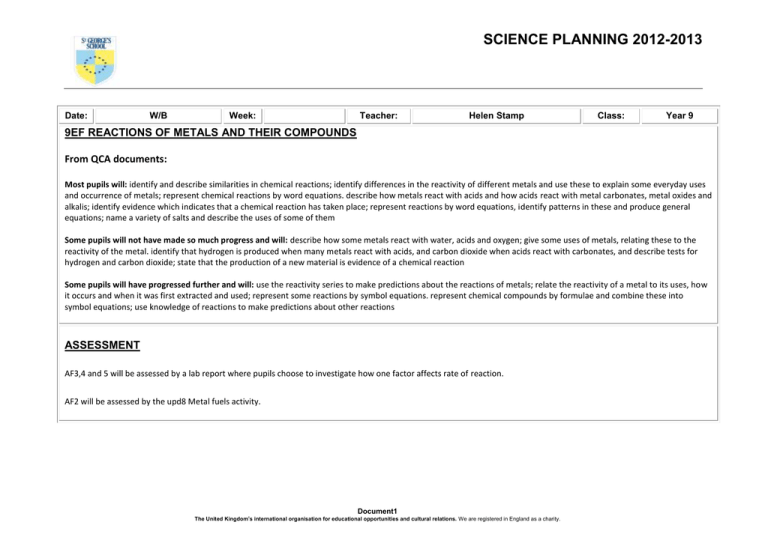9E PLAN - stgeorgescpd
advertisement

SCIENCE PLANNING 2012-2013 Date: W/B Week: Teacher: Helen Stamp Class: Year 9 9EF REACTIONS OF METALS AND THEIR COMPOUNDS From QCA documents: Most pupils will: identify and describe similarities in chemical reactions; identify differences in the reactivity of different metals and use these to explain some everyday uses and occurrence of metals; represent chemical reactions by word equations. describe how metals react with acids and how acids react with metal carbonates, metal oxides and alkalis; identify evidence which indicates that a chemical reaction has taken place; represent reactions by word equations, identify patterns in these and produce general equations; name a variety of salts and describe the uses of some of them Some pupils will not have made so much progress and will: describe how some metals react with water, acids and oxygen; give some uses of metals, relating these to the reactivity of the metal. identify that hydrogen is produced when many metals react with acids, and carbon dioxide when acids react with carbonates, and describe tests for hydrogen and carbon dioxide; state that the production of a new material is evidence of a chemical reaction Some pupils will have progressed further and will: use the reactivity series to make predictions about the reactions of metals; relate the reactivity of a metal to its uses, how it occurs and when it was first extracted and used; represent some reactions by symbol equations. represent chemical compounds by formulae and combine these into symbol equations; use knowledge of reactions to make predictions about other reactions ASSESSMENT AF3,4 and 5 will be assessed by a lab report where pupils choose to investigate how one factor affects rate of reaction. AF2 will be assessed by the upd8 Metal fuels activity. Document1 The United Kingdom’s international organisation for educational opportunities and cultural relations. We are registered in England as a charity. Learning objectives 2 1 1 APP areas Main Teaching Content Differentiation To know what an element is To know where metals and nonmetals are found in the periodic table To be able to name properties of metals and non-metals Recap of year 8 work Pupils to colour periodic table to show position of metals, metalloids and non-metals Recap the meaning of element ICT lab Pupils research properties of metals and non-metals Extension: look for unusual metals and non-metals that do not have the properties To know that a metal oxide is produced when metals react with oxygen To know that different metals are more or less reactive with oxygen Reactions with oxygen Demo burning Magnesium Write down observations and word equation Pupils use counting cubes to help balance symbol equation Pupils burn copper Write down observations and word equation Pupils use counting cubes to help balance symbol equation Pupils write a conclusion about the reactions of the two metals. Extension: compare with the reaction of Iron with metal Support: No symbol equations or no balancing To know that group I is called the Alkali Metals To know that some metals react with water To know that the groups I metals are very reactive To know that the reactivity increases down the group To be able to write word equations for reactions of metals and water Reactions with water Demo Group I metals and pupils write down observations pH test the water at the end Write word equations Pupils do the reactions of Group II metals Page 2 of 3 Extension: Symbol equations Plenary Compare their discoveries with partners. H/W 2 To know that when a metal reacts with an acid hydrogen and a salt are produced. Metals and acids Pupils react Magnesium, Zinc, Iron and Copper with 0.1M HCl They write a conclusion putting the metals in order of reactivity and write word equations. To know that metals can be put in order of their reactivity To understand that we can observe reactions of metals with various substances to investigate their reactivity Reactivity series Pupils fill in table using results from their experiments so far. Video and demos of reactions with oxygen. Try to write order in the last column. Show them the real reactivity series To know that when an acid reacts with a carbonate Carbon dioxide, water and a salt are produced. To be able to name some examples of carbonates Acids and carbonates Pupils do experiments with HCl and chalk, marble, bicarbonate and indigestion tablets They describe the results Write word equations Extension: Balanced symbol equations To know that metals higher up the reactivity series will displace others To be able to write word equations for displacement reactions Extension: To be able to write balanced symbol equations for displacement reactions Displacement reactions Pupils do the displacement reaction with dimple trays and write a conclusion of their results Discussion of which reacted and why Displacement reaction worksheet Extension: Balanced symbol equations of conclusion 2 Write conclusions for both water and acid experiments. LOQ and number of atoms sheet. Extension: Symbol equations Plenary cards. Word equations sheet Extension: write symbol equations too 2 1 3 To know how to test for Oxygen, Carbon dioxide and Hydrogen AF3,4, 5 Gas tests recap Show video and write notes down Assessed practical Brainstorm factors which may affect rate of reaction Pupils investigate how one factor affects rate of reaction with Calcium carbonate and Hydrochloric Acid Page 3 of 3 Plenary cards. Support: Plan, do and review sheet Write up experiment







